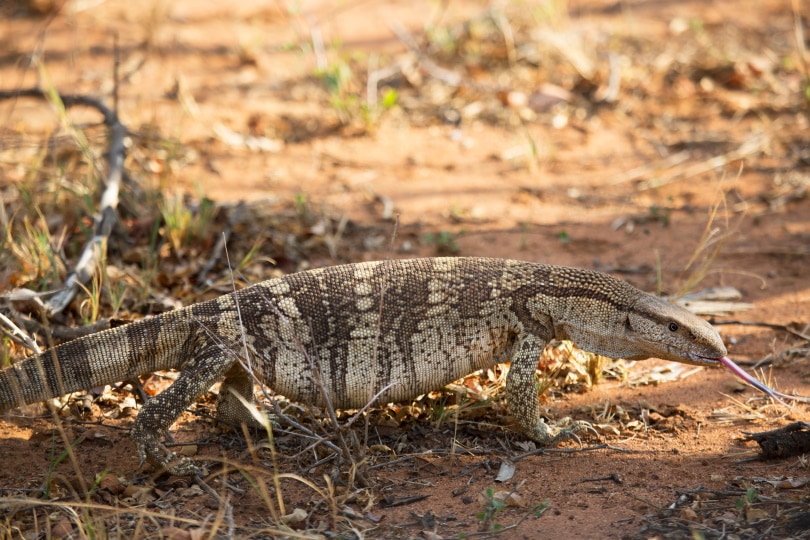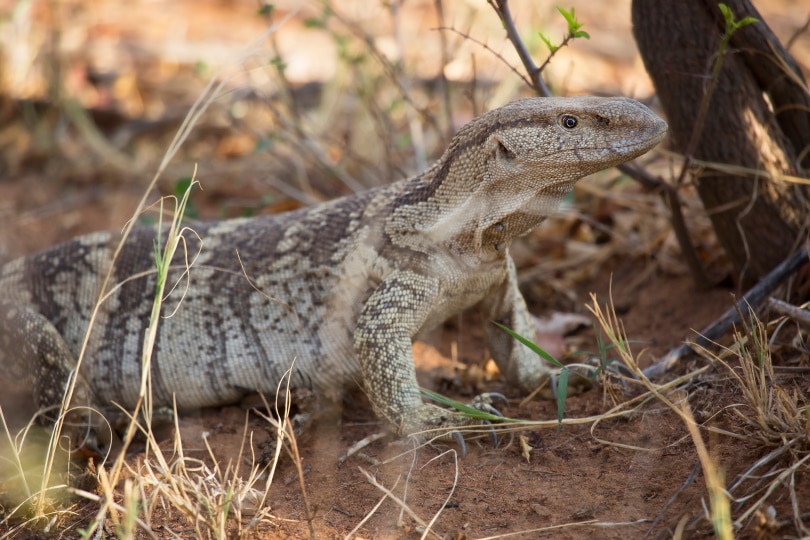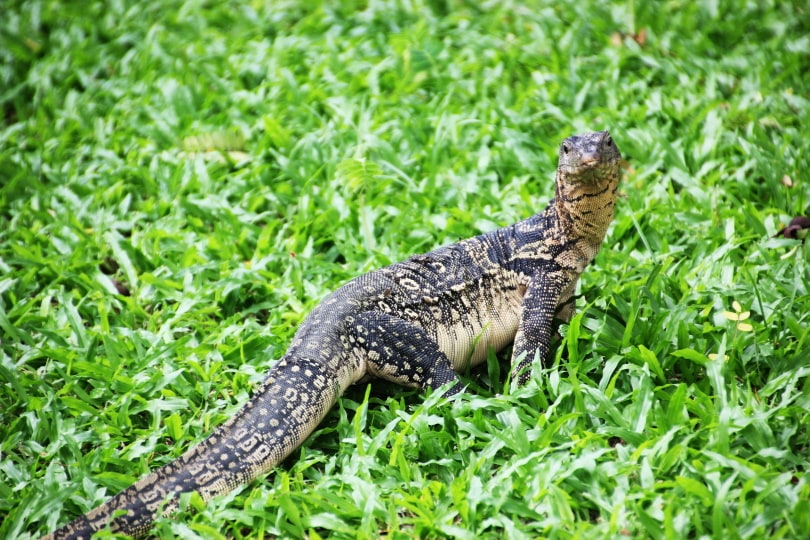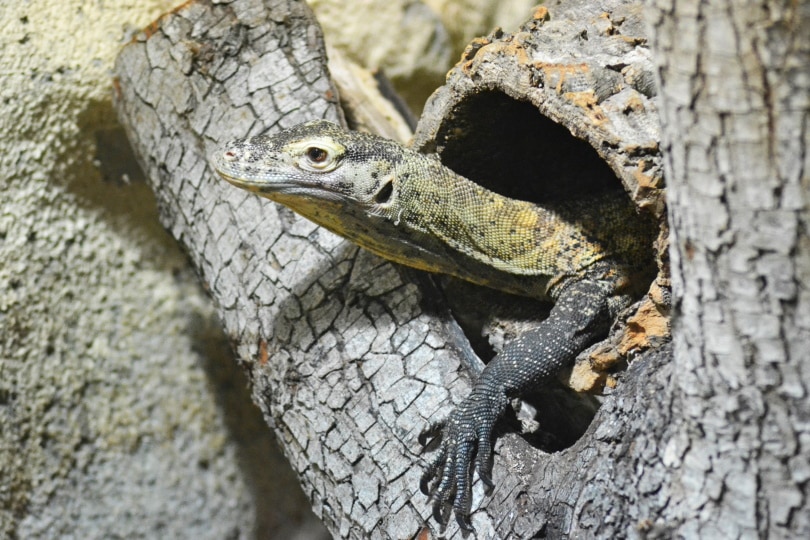

The white-throated monitor lizard is native to Southern Africa. They are quite large, reaching up to 6 feet in length! These lizards are not great pets for an inexperienced owner. They need plenty of space to move around and the right habitat to thrive in.
If you are up for the challenge and are interested in learning more about the white-throat monitor lizard, read on!

Quick Facts about the White-Throated Monitor Lizard
| Species Name: | Varanus albigularis albigularis |
| Family: | Varanidae |
| Care Level: | Fairly high maintenance |
| Temperature: | 75 to 105 degrees Fahrenheit |
| Temperament: | Playful, intelligent, can lash out |
| Color Form: | Dark brown with a lighter belly; white throat |
| Lifespan: | 12 to 20 years |
| Size: | 3 to 6 feet in length |
| Diet: | Birds, insects, invertebrates, snails |
| Minimum Enclosure Size: | Minimum 6’ x 4’ enclosure is needed; may need a full room-sized enclosure |
| Enclosure Set-Up: | Hiding spots; space to move |
| Compatibility: | Can be aggressive towards others of the same sex |
White-Throated Monitor Lizard Overview

Monitor lizards are one of the most interesting families of lizards because of both their large size and high level of intelligence. The white-throated monitor lizard is smaller than their cousin, the black-throated monitor, but they still can grow to be an impressive 6 feet in length.
Many handlers claim that their white-throated monitor lizard can learn to recognize their owner after they have been working with them for a short time. There have also been experiments that indicate that white-throat monitors are capable of remembering the amount of food they receive. When given less food, the monitor lizards showed signs of stress until the correct amount was restored.
As pets, white-throat monitor lizards need a lot of space and an experienced handler. Furthermore, they should never be taken from the wild and kept as pets. The number of wild white-throat monitor lizards has been steadily declining, partially as the result of capture for the pet trade. The pet trade is not well regulated, nor is it good for the wild population.
They are not animals that can be kept in a small cage and observed. Monitors require a large enclosure, highly regulated temperatures, and special care. Most often, the best place for them in captivity is in a zoo.
How Much Do White-Throated Monitor Lizards Cost?

Due to the lack of regulation in the white-throated monitor lizard pet trade, the price of purchase can vary widely. A baby white-throat can cost anywhere from $400 to $700, or more. The price heavily depends on where you purchase the lizard. It is important to note that there is little to no guarantee that you will receive a healthy lizard. Nor is there a guarantee that it has not been taken from the wild or bred from parents taken from the wild.
Typical Behavior & Temperament
Monitor lizards are playful and intelligent. They need to be handled regularly if they are held in captivity so that they don’t become bored and aggressive.
The white-throated monitor lizard likes to burrow and hide under rocks, logs, and other materials.
They can also become stressed easily if not properly cared for. When the white-throat monitor is stressed, it may become aggressive toward its handlers. Monitor lizards need exercise, too. They can be taken on walks with a leash and harness, however, the temperature outside needs to be warm enough for them.
Male white-throat monitors are extremely territorial and do not tolerate one another’s company at all.
Appearance & Varieties

The white-throated monitor lizard typically grows to be anywhere from 3 to 6 feet in length. They can weigh anywhere from 10 to 18 pounds, with the males usually trending towards the heavier and longer side of the range.
They have a short, blunt nose and raised neck scales. The top of their necks, backs, and heads are dark brown or grey and their throat is white. They have a lighter, yellowish stomach. They also have white or yellow spots of varying sizes on their backs, heads, and legs.
Their tongues are forked, like a snake. This leads some to believe that they are the lizard most closely related to a snake. The monitor has long, strong claws used for digging and hunting.
How to Take Care of a White-Throated Monitor Lizard

Habitat, Tank Conditions & Setup
White-throated monitor lizards need very specific enclosures, temperature control, and lighting to remain healthy and happy. The best place in captivity for them to get these things is usually in a zoo or other specialized wildlife refuge.
Enclosure
The minimum enclosure size for a young white-throat monitor is 6’ x 4’. However, as they grow, they will need more space. It is usually necessary for them to have a room-sized enclosure with plenty of places for them to hide and climb. The enclosure needs to be strong and usually is made of wood and plexiglass. It also needs to have proper ventilation.
Bedding
The white-throat monitor needs at least 18 inches of soft substrate like soil. They like to burrow and rub their prey in the soil so this is the best choice of bedding for a monitor lizard.
Temperature
The white-throat monitor needs access to a range of temperatures between 75 degrees Fahrenheit (F) for a cool area and as high as 105 degrees F for a basking area. They should be able to move between these temperatures whenever they want to. The humidity should be between 20% and 50%.

Lighting
These lizards need 12 hours of light and 12 hours of dark each day. They also need UVB lighting to help them metabolize the calcium they get from their diet.
Other Materials
The white-throat monitor likes hiding places to make them feel safe. Their enclosure should include several options for hiding such as logs, plants, or rocks.
Do White-Throat Monitor Lizards Get Along with Other Pets?
If a white-throated monitor lizard is kept as a pet, it should not be around other pets. They are aggressive towards their species, especially males. They may see other pets as prey and try to hunt them. They can also become aggressive and lash out if they feel stressed or threatened.
What to Feed Your White-Throated Monitor Lizard

In the wild, the white-throated monitor lizard will eat anything they can hunt down. In captivity, they generally eat mice, rats, fish, crickets, worms, hard-boiled eggs, and shellfish. If you are feeding them eggs, the eggs should be cooked to prevent salmonella.
They also need access to fresh water daily. The amount of food and water your white-throated monitor lizard needs will be highly dependent on its size, life stage, and the time of the year. They have been known to gorge themselves when food is available, and go for a long time without eating when it is scarce.
In general, they need to be fed a few times per week. You should monitor their weight to make sure they are not getting too much or too little food.
Keeping Your White-Throated Monitor Lizard Healthy
The white-throated monitor lizard requires specific care to remain healthy. The temperature and humidity level in their enclosure needs to be kept at the proper levels to prevent excess shedding or stress.
They need enough UVB light to properly metabolize the calcium in their diet. A lack of proper UVB lighting can lead to a lethargic lizard. Monitor lizards are also prone to constipation because much of what they eat is difficult to digest.
If you notice anything unusual with the behavior or appearance of your lizard, you should immediately have them seen by an exotic animal veterinarian.

Breeding
Many of the white-throat monitor lizards in the pet trade today have been taken from the wild. The breeding and trade of these lizards are not well regulated, thus it is difficult to assess where a lizard comes from. Some zoos and other wildlife programs are working to protect the white-throat monitors in the wild and properly breed them in captivity.

Are White-Throated Monitor Lizards Suitable For You?
While the white-throated monitor lizard is an interesting and intelligent animal, it is not a great choice as a pet for most people. They are wild animals that have specialized requirements for their care. They need large enclosures and a handler who knows what they are doing. However, many zoos have white-throat monitors. If you want to see one in a healthy, appropriate environment, this may be the best place to do so!
Featured Image Credit: Dirk M. de Boer, Shutterstock
Nicole is the proud mom of Baby, a Burmese cat and Rosa, a New Zealand Huntaway. A Canadian expat, Nicole now lives on a lush forest property with her Kiwi husband in New Zealand. She has a strong love for all animals of all shapes and sizes (and particularly loves a good interspecies friendship) and wants to share her animal knowledge and other experts’ knowledge with pet lovers across the globe.





